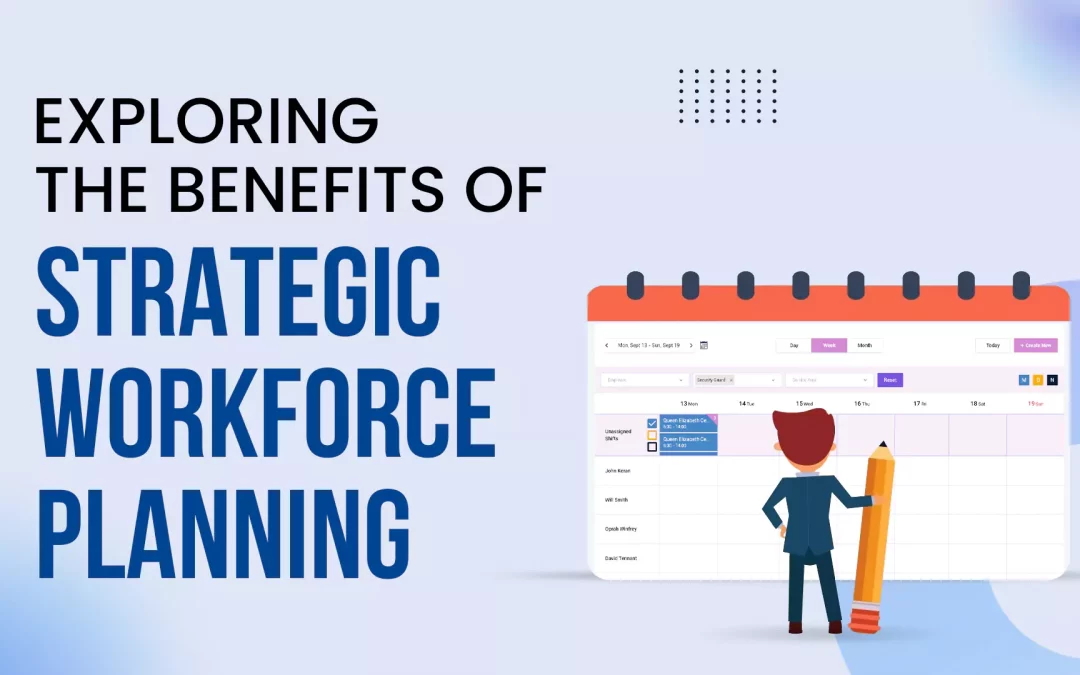Suppose you are working for a high-value client on a special project. During the project, you fell short of staff due to poor strategic workforce planning. This is quite an embarrassing situation with negative long-term consequences on your business reputation and growth.
To avoid similar situations in the future, always forecast your labor requirements through strategic workforce planning. By taking a proactive, data-driven approach to workforce management, your organization can better predict and respond to changes in the market and the ever-evolving needs of your customers. Besides, it will prepare you for upcoming challenges and help you achieve operational efficiency.
In this article, we’ll explore the benefits of strategic workforce planning and discuss some of the key factors to consider when creating a plan that’s right for your business.
So, let’s get started!
What Is Strategic Workforce Planning?
Strategic workforce planning is the process of anticipating future workforce needs and taking action to ensure you have the right people in the right jobs at the right time. It’s all about ensuring your business has the resources it needs to be successful in the future, whether that’s through hiring new staff, training existing employees, or outsourcing work.
Workforce planning helps you stay agile and responsive to changes in the market. You’ll be able to make rapid decisions about new hires and changes to your workforce without having to worry about the impact on your business. Besides, it gives you a better understanding of your future hiring needs so that you can plan ahead and avoid any unexpected shortages.
Benefits of Strategic Workforce Planning
Strategic workforce planning can benefit your organization in many ways, such as:
1. Improved Team Performance
Unexpected labor shortages negatively affect team performance and ultimately lead to declined growth. To effectively complete a project within your estimated deadline, you need sufficient workers with your desired skills and expertise.
With strategic workforce planning, you can optimize your workforce in such a way that you have enough team members to complete a task. With accurate forecasting, you never fall short of the required team members and improve overall team performance.
2. Better Operational Efficiency
By implementing workforce planning, you can improve operational efficiency, develop better recruitment strategies, and help identify potential future needs. This helps create a roadmap for your organization’s future success.
Eventually, you can communicate the resulting plan across different departments to ensure everyone is on the same page, and working towards the same goals.
3. Informed Decision-making
Strategic workforce planning allows team leaders to measure key metrics such as attrition rates, employee engagement, recruitment costs, and working capital. By tracking these metrics over time, it’s easier to understand how effective strategic workforce planning is at achieving desired outcomes.
Similarly, you can keep an eye on talent gaps and opportunities and stay ahead of industry changes. Doing so ensures that your organization has the right talent in place when needed and can help prevent problems from occurring later down the road. Moreover, measurement also allows for course adjustments if something isn’t working as expected, you can adjust accordingly for better results.
4. Corporate Growth
Another key benefit of strategic workforce planning is that you can identify skill gaps and potential areas of growth, ensuring that you have the right people in the right roles. And by developing a succession plan, you can create a roadmap for replacing critical positions when necessary.
Additionally, strategic workforce planning is a way to assess the dynamics of the workforce and determine if the organization needs any changes to achieve its goals. As a result, proper planning and execution can help you boost your corporate growth and stay ahead of your competitors.
Key Considerations in Strategic Workforce Planning
When it comes to strategic workforce planning, there are a few key considerations that your business should take into account.
- First, you need to have a clear idea of your business goals and objectives. Answer questions about the short-term and long-term goals you aim to achieve. Based on these goals, estimate your current and future staffing needs. Lastly, identify what skills and capabilities you need in your workforce to achieve these goals.
- Next, make sure you have a good understanding of the current and future labor market. Identify the key players, skills, and experience that are in high demand and the current state of the labor market. Moreover, also evaluate how these changes will evolve over time.
- Finally, have a well-defined people strategy that outlines your approach to staffing. Define the approach you will follow to identify and attract top talent and the tools you will use for workforce planning. Likewise, finalize how you will manage changes in staff requirements as your business grows in the future.
Final Words
Strategic workforce planning is the process of forecasting the current and future labor requirements based on corporate goals. It involves an analysis of your business objectives and a review of current and predicted workforce levels and competency requirements. Besides, you also need to evaluate your current employees to understand the skills gap that needs to be filled.
When developing your workforce planning strategy, it’s important to consider external factors such as labor laws, competitive market forces, technology advancements, and economic trends. By understanding external factors, you can ensure your strategy covers all bases and helps position your organization for success.
By implementing strategic workforce planning, you can get benefits like enhanced workforce agility, improved decision-making, and better organizational efficiency. Moreover, you can achieve maximum employee retention and great business stability.
